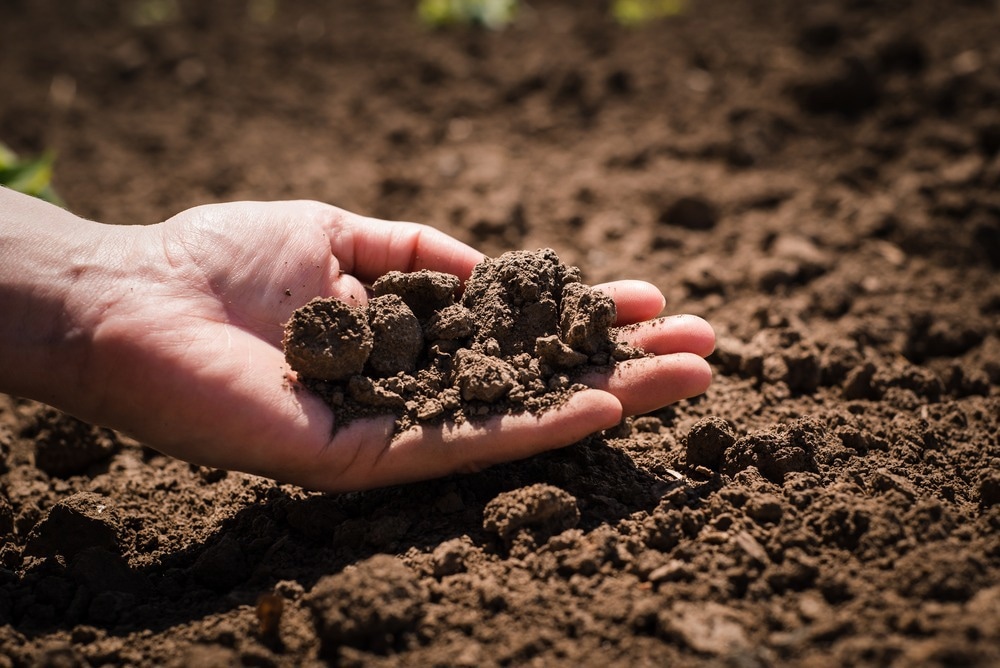Reviewed by Danielle Ellis, B.Sc.Aug 14 2023
In a recent study, a team of researchers led by Penn State discovered hints that could assist in better understanding the role microbes play in creating a living skin over many semi-arid ecosystems around the world. They did this by using a novel method to detect microbial activity in biological soil crusts or biocrusts after they have been wetted. Climate change poses a challenge to the microscopic organisms and the microbiomes they produce.

Image Credit: funnyangel/Shutterstock.com
Frontiers of Microbiology published the findings.
Biocrusts currently cover approximately 12% of Earth’s terrestrial surface, and we expect them to decrease by about 25% to 40% within 65 years due to climate change and land-use intensification. We hope this work can pave the way to understanding the microbial functions supporting biocrust resilience to the rapidly changing climate patterns and more frequent droughts.”
Estelle Couradeau, Study Team Leader and Professor, Soils and Environmental Microbiology, The Pennsylvania State University
A persistent, well-organized surface layer of soil is called a biological soil crust and is made up of assemblages of organisms. They can be found all over the world; anywhere there is a water deficit that prevents the development of common plants and allows light to reach bare soil.
However, there is still enough water to sustain the development of microorganisms that provide essential ecosystem services, including fixing carbon and nitrogen from the air in the soil, recycling nutrients, and binding soil particles together to reduce dust.
According to Couradeau, this soil-stabilizing function is crucial because it prevents erosion by giving the soil the ability to clump together rather than turn into dust. Her research team has been investigating biocrusts in-depth for 10 years and is currently based in Penn State’s College of Agricultural Sciences.
Couradeau added, “Most dust is generated in drylands, and studies suggest that the presence of biocrusts in drylands greatly reduce the amount of dust that would otherwise make its way into the atmosphere. We think losing biocrusts would cause a 5% to 15% increase in global dust emission and deposition—which would affect the climate, environment and human health.”
According to Ryan Trexler, a doctoral candidate in the Intercollege Graduate Degree Program in ecology and biogeochemistry who led the research, the organisms—tiny mosses, lichens, green algae, cyanobacteria, other bacteria, and fungi—can only encounter a few rain or snow events per year in the semi-arid regions where biocrusts exist.
When the soil is dry, for the most part, the microbes in the soil are dormant, not doing much. But as soon as they sense water, they are resuscitated very quickly, within seconds to minutes. And they are actively making chlorophyll and fixing carbon and nitrogen until the soil is dry again—and then the microbes go dormant again. They go through cycles of activity every time it rains.”
Ryan Trexler, Doctoral Student, The Pennsylvania State University
The researchers collected samples from three plots of undisturbed, cyanobacteria-dominated biocrusts on the Colorado Plateau close to Moab, Utah, to examine biocrusts. Samples of biocrust were collected in the autumn after rain that adequately moistened the soil to activate the bacteria. After that, the samples were dried, kept in the dark, and rewetted considerably later in the investigation.
Trexler added, “We sampled what we call ‘a cold desert,’ because it is very arid, but in the winter, it sometimes snows. So, it is not as hot as many other arid places, but still plants cannot thrive there because there is not enough water. And so, the only community that we find in soils at the site are microbial.”
The researchers combined fluorescence-activated cell sorting with bioorthogonal non-canonical amino acid tagging, or BONCAT, to identify which bacteria are present in soil ecosystems.
Fluorescence-activated cell sorting classifies cells according to whether they are making new proteins, whereas BONCAT is an effective method for monitoring protein synthesis at the level of individual cells within communities and whole organisms.
By combining these techniques with shotgun metagenomic sequencing, the researchers were able to thoroughly sample every gene in every organism present in the biocrust samples.
After being revived by a simulated rain event, they used this technique to characterize the variety and potential functional capacities of both active and dormant microorganisms in a biocrust community. The researchers discovered that wetted biocrusts can differentiate between active and inactive bacteria using their new technique.
At four hours and 21 hours following the wetting event, the active and inactive parts of the biocrust community had different species richness and composition.
Source:
Journal reference:
Trexler, R. V., et al. (2023). BONCAT-FACS-Seq reveals the active fraction of a biocrust community undergoing a wet-up event. Frontiers of Microbiology. doi.org/10.3389/fmicb.2023.1176751